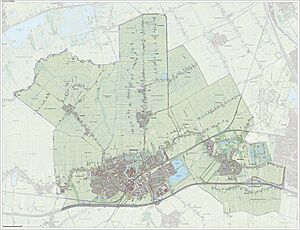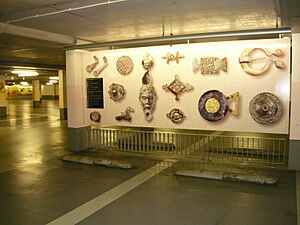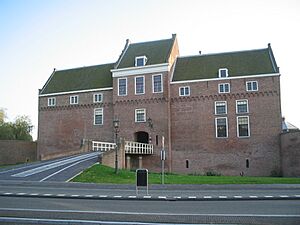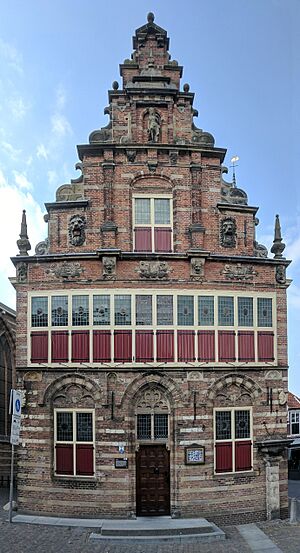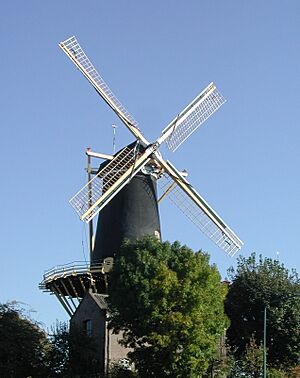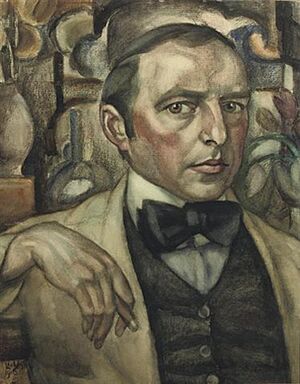Woerden facts for kids
Woerden is a city and a municipality located in the central part of the Netherlands. It's a popular place for people who work in bigger cities like Amsterdam, Rotterdam, The Hague, and Utrecht. This is because Woerden is right in the middle of these cities and has good train and road connections to them.
Quick facts for kids
Woerden
|
|||
|---|---|---|---|
|
City and Municipality
|
|||

Aerial view of Woerden in 2013
|
|||
|
|||

Location in Utrecht
|
|||
| Country | Netherlands | ||
| Province | Utrecht | ||
| Government | |||
| • Body | Municipal council | ||
| Area | |||
| • Total | 92.92 km2 (35.88 sq mi) | ||
| • Land | 89.35 km2 (34.50 sq mi) | ||
| • Water | 3.57 km2 (1.38 sq mi) | ||
| Elevation | 0 m (0 ft) | ||
| Population
(May 2014)
|
|||
| • Total | 50,593 | ||
| • Density | 566/km2 (1,470/sq mi) | ||
| Demonym(s) | Woerdenaar | ||
| Time zone | UTC+1 (CET) | ||
| • Summer (DST) | UTC+2 (CEST) | ||
| Postcode |
3440–3449, 3470–3481
|
||
| Area code | 0348 | ||
Contents
History of Woerden
The Oude Rijn river used to flow right through the middle of Woerden. But in 1960, the river was moved to go around the city center instead.
Woerden has a long and interesting history, especially when it comes to making and trading cheese. For many years, Gouda cheese for both local and international use has been made in this area. Woerden still has its traditional cheese market, which has been held since 1885, in the city center.
Roman Fort in Woerden
Woerden is located on the Oude Rijn river. This area was a good place for people to settle because it was a bit higher than the land around it, which often flooded.
The Romans built a fort here, called a castellum, as part of their border defenses. This fort was named Castellum Laurum. The first fort was built in the 40s AD. It was destroyed in 69 AD during a rebellion, but then rebuilt in 70 AD. The Romans stayed in Woerden until 402 AD.
Today, the medieval Petruschurch stands where the Roman fort used to be. During construction of a new underground parking garage, workers found parts of old Roman buildings and even a Roman cargo ship! These discoveries helped experts learn a lot about Roman times in Woerden.
Woerden in the Dark Ages
Not much is known about Woerden right after the Romans left in 402 AD. People likely still lived there, but there isn't much proof from that time. An old Frankish sword from the 8th century was found at the Roman fort site in 2012.
The area was often fought over by the Frisians and the Franks. Different kings and dukes controlled the area at different times. Important religious leaders, called missionaries, also came to the area. For example, Willibrord became the Bishop of Utrecht in 695 AD. Another missionary, Boniface, worked here from 719 to 722. He preached in a place called Wyrda, which meant it was on higher ground.
Around 850 AD, the Bishop had to leave because of Viking raiders. But the Bishop returned in 918 AD after the Vikings were less of a threat.
Between Bishop and Count
The Bishop of Utrecht was given land by kings and became a powerful ruler. Around 1000 AD, most of the land around Woerden was undeveloped swamp. The bishops encouraged settlers to drain these swamps by digging ditches. This created the organized grid of fields you can still see today.
At the same time, another powerful area grew to the west, called Holland. The Counts of Holland expanded their power. Around 1160, the Bishop of Utrecht built a castle in Woerden. This made Woerden a border town between two fighting powers. This situation lasted until 1527, when the Bishop sold his lands to Emperor Charles V, and the areas were united.
Because of its important location, many wars were fought in and around Woerden. From about 1131 to 1296, the van Woerden family was very important locally. They tried to become independent from the Bishop. In 1278, Floris V, Count of Holland, stepped in and defeated the rebellious lords. Woerden eventually became part of Holland.
Around 1370, walls and a moat were built to protect Woerden. The city received its city rights in 1372, even though it was still a small town with only about 720 people. The Petruschurch was built around this time, and part of its steeple still stands. The Castle of Woerden was built in 1410, and the city hall in 1510. These buildings are still there today.
Woerden had a peaceful time from 1419 to 1477 under the rule of the Dukes of Burgundy. During this time, its population almost tripled! However, after 1477, there was more unrest and economic problems.
Important Events and People
A famous scholar named Erasmus might have lived in Woerden as a young boy from age five to nine, around 1471.
The time of Emperor Charles V was generally peaceful for Woerden, even with some religious disagreements. In 1522, the Inquisition was introduced in the Netherlands.
Jan de Bakker (1499–1525) was a Catholic priest from Woerden. He was one of the first preachers in the Northern Netherlands to be put to death because of his religious beliefs. He started sharing ideas that were different from the official church teachings. He also broke his promise of celibacy and got married.
In 1525, Jan de Bakker was arrested and taken to The Hague. He was found guilty and put to death on September 15, 1525. His wife was able to save her life by changing her views and lived in an abbey.
The city leaders of Woerden were quite open to different religious ideas. This led to some conflict with Duke Eric of Brunswick, who was the Lord of Woerden at the time. Duke Eric, who had converted to Catholicism, wanted Catholic worship to be restored in Woerden. He even used a small army to make the city leaders agree.
Woerden was later occupied by the Spanish (in 1575 and 1576) and the French (in 1672, 1673, and especially in 1813, which was a very difficult time).
Modern Woerden
In 1989, the borders of provinces were changed, and Woerden moved from the province of South Holland to the province of Utrecht.
Geography of Woerden
Woerden is located at 52°5′N 4°53′E / 52.083°N 4.883°E in the western part of the province of Utrecht, right in the center of the Netherlands.
Woerden shares borders with several other municipalities:
- To the north: De Ronde Venen
- To the northeast: Stichtse Vecht
- To the east: Utrecht
- To the south: Montfoort
- To the southwest: Bodegraven-Reeuwijk
- To the northwest: Nieuwkoop
The main towns and villages within the municipality of Woerden are De Meije, Harmelen, Kamerik, Kanis, Woerden itself, and Zegveld.
Notable People from Woerden
Many interesting people have come from Woerden:
- Jan de Bakker (1499–1525), a Protestant who was put to death for his beliefs.
- Herman van Swanevelt (1603–1655), a painter and etcher from the Baroque period.
- Leo Gestel (1881-1941), a Dutch modernist painter.
- Herman de Man (1898–1946), a novelist.
- Jaap Blonk (born 1953), a composer and performance artist.
- Gerda Verburg (born 1957), a politician and diplomat who lives in Woerden.
- Simone Angel (born 1971), a TV host and singer.
Sports Stars from Woerden
Woerden has also produced many talented athletes:
- Arie van Vliet (1916–2001), a track cyclist who won medals at the 1936 Summer Olympics.
- Peter Prijdekker (born 1948), a freestyle swimmer who competed at the 1972 Summer Olympics.
- Sam Oud (born 1978), a slalom canoeist who competed at the 2004 Summer Olympics.
- Esther Vergeer (born 1981), a famous wheelchair tennis player.
- Erwin l'Ami (born 1985), a chess grandmaster.
- Petra Hillenius (1968–2020), a breaststroke swimmer who competed at the 1984 Summer Olympics.
- Anouk Hoogendijk (born 1985), an international footballer.
- Jiske Griffioen (born 1985), a former wheelchair tennis player and three-time Paralympic medalist.
- Ellen van Dijk (born 1987), a professional racing cyclist.
- Floortje Mackaij (born 1995), a professional racing cyclist.
Buildings in Woerden
- Water Tower Woerden
Schools in Woerden
- Kalsbeek College
- Minkema College
- Futura College
Transportation in Woerden
- Woerden railway station
Train Accidents
Woerden has been the site of a few serious train accidents:
- The Woerden train accident in November 1960, which resulted in 2 deaths and 10 injuries.
- The Harmelen train disaster in January 1962, which was a head-on collision and the worst railway accident in the history of the Netherlands, with 93 deaths.
Images for kids
See also
 In Spanish: Woerden para niños
In Spanish: Woerden para niños




